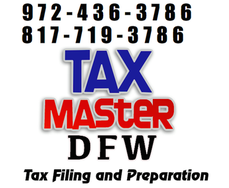Nine Ways to Exit Your Company
by Tax Master DFW on 11/17/14
Title:
Nine Ways to Exit Your Company
Word Count:
808
Summary:
As many of you may remember, singer Paul Simon said there are 50 ways to leave a lover. If you are a business owner thinking about how to leave your business you have nine options to consider. This article contains a brief summary of the pros and cons of these options.
Keywords:
#Arlington_Tax_Preparation, #Tax_Preparation, #Tx_Tax_prep, #Texas_Tax_Preparation, #Arlington_Tax_Prep, #Arlington_TX, #Tax_Prep, #DFW_Tax_Prep, #Tax_Filing, #Taxes, #Lewisville_Tax_Prep, #Lewisville_Tax_Preparation, #DFW_Tax_Preparation, #Arlington, #Tarrant_County, #Reduce_Taxes, #Tax_Refunds, #Pay_Taxes, #Tax_Help, #Bookkeeping, #DFW_Bookkeeping, #Investing, #tax_bookkeeping, #DFW, #Texas, #North_Texas, #Filing_Taxes, #1099, #W-2, #W-4, #W-9
Article Body:
As many of you may remember, singer Paul Simon said there are 50 ways to leave a lover. If you are a business owner thinking about how to leave your business you have nine options to consider. Here's a brief summary of these options.
1. Sell or give your company to a family member;
2. Sell your business to one or more key employees;
3. Sell to your employees (ESOP);
4. Sell your business to other shareholders;
5. Sell to an outside third party;
6. Bring in an outside investor and keep a minority interest
7. Go public;
8. Hire a management team to take over and become a passive owner; or
9. Liquidate your business.
Determining exactly which option is right for you is a challenge that many business owners put off until it is too late. Opportunities pass with time. If you wish to "leave your business on your terms and on your time table," you need to be proactive about understanding your exit options.
We recommend that you follow a four-step process to determine which exit option is best for you. This process will ensure that your exit options are consistent with your personal goals and take into account the realities of your company and the marketplace.
Choosing a Path
Step One: Set Personal Goals. You need to identify your most important objectives; both in terms of financial goals ("How much money do I need from the exit to ensure my familyís financial security?") and in terms of non-financial goals ("I want the company to stay in my family," or "I want to my key employees to be rewarded during the exit"). Establishing well defined and written objectives is the first step in the exit planning process. Doing so in advance of your exit gives you and your advisors the time necessary to make your goals a reality.
Step Two: Make Sure Goals are Consistent. With the help of your advisors you need to determine whether your goals are consistent with each other. Very often this is not the case. For example, many business owners want to receive all cash at closing when they exit their business. At the same time the owner may want to transfer the business to a family member or a key employee. Unfortunately, these two goals may be mutually exclusive. Family members and key employees often do not have sufficient capital to structure a transaction this way. A great deal of stress and heartache can be avoided by addressing these kind of issues early in the process.
Step Three: Understand Value and Salability Issues. Once you have defined a set of consistent objectives, you need to understand the market value and salability of your company. This analysis is important in that it will provide you with further direction and can eliminate certain exit options.
For example, if the value of your company is below what you feel you need to support a comfortable lifestyle after your exit, you may decide to take some time to enhance the value of your business or to do further financial planning to ensure you clearly understand your financial needs.
In addition to understanding the value of your company you also need to understand how salable your business is. Value and salability are not always the same. Salability determines how quickly a business will sell and how much leverage a business owner will have when negotiating with a buyer. Salability depends to a large extent on external market conditions. External conditions are things that are out of your direct control like business, market or financial conditions. For example, the option of selling your business for cash to an outside buyer may be eliminated because of a downturn in your business or industry.
We recommend that you work with an investment banking firm to determine the value and salability of your company. Only an investment bank that is actively talking with buyers can give you an accurate read of the marketplace and a "real world" sense of the value and salability of your company.
Step Four: Understand Tax and Legal Implications. The final step in determining the best exit path for you is to a path is to evaluate the tax and legal consequences of the exit options that are available to you. This evaluation will include factors such as legal structure of your business entity, how its ownership is structured, exiting legal agreements, as well as any changes that must be made. For example, if a transaction involves a sale of assets and the company is a "C" corporation, there would be significant adverse tax consequences. Good advice from your CPA and attorney can help minimize the taxes you would otherwise have to pay.
Using this four-step process, you will be able to narrow the list of exit routes to determine which one is best for you. The important thing is to start early.
Comments (0)








